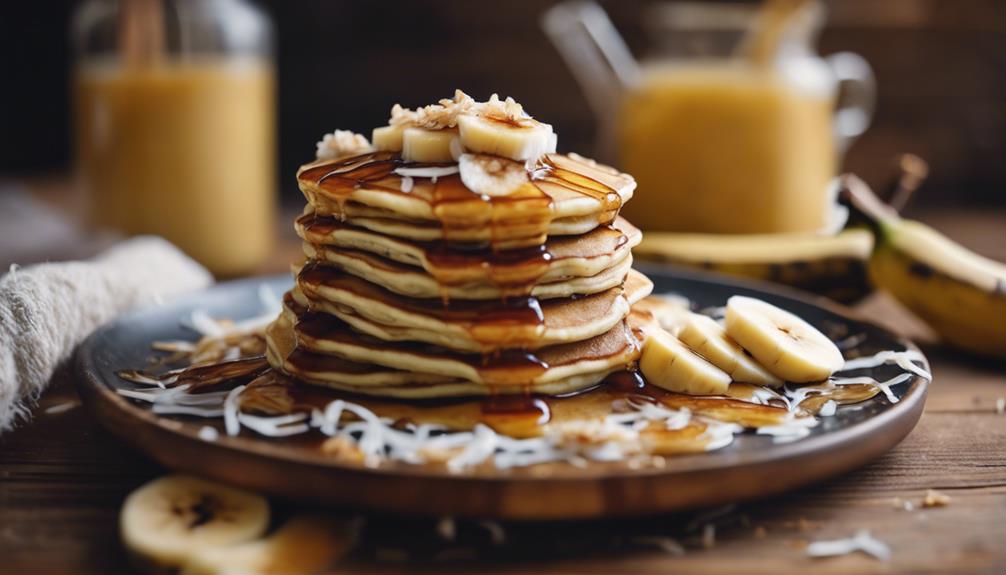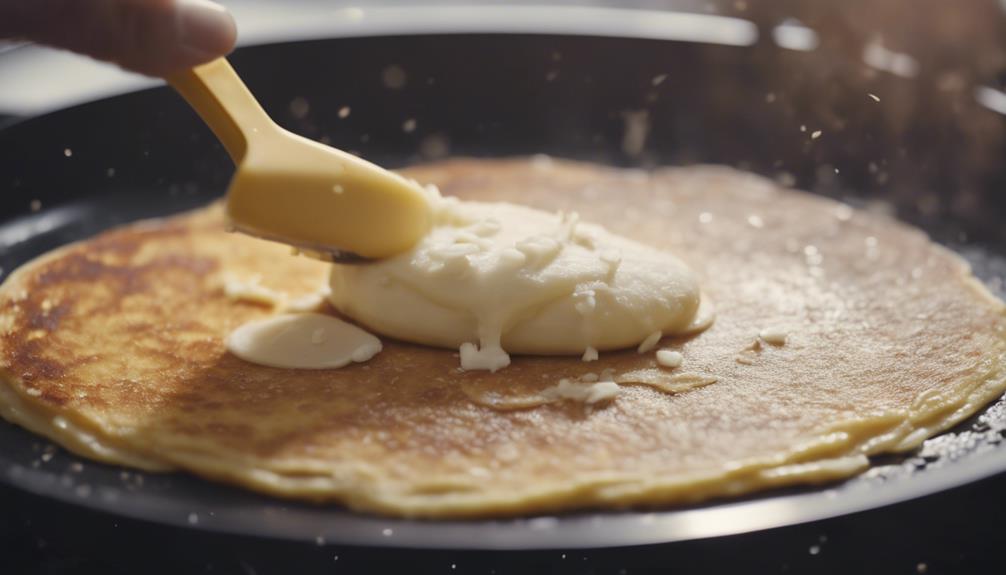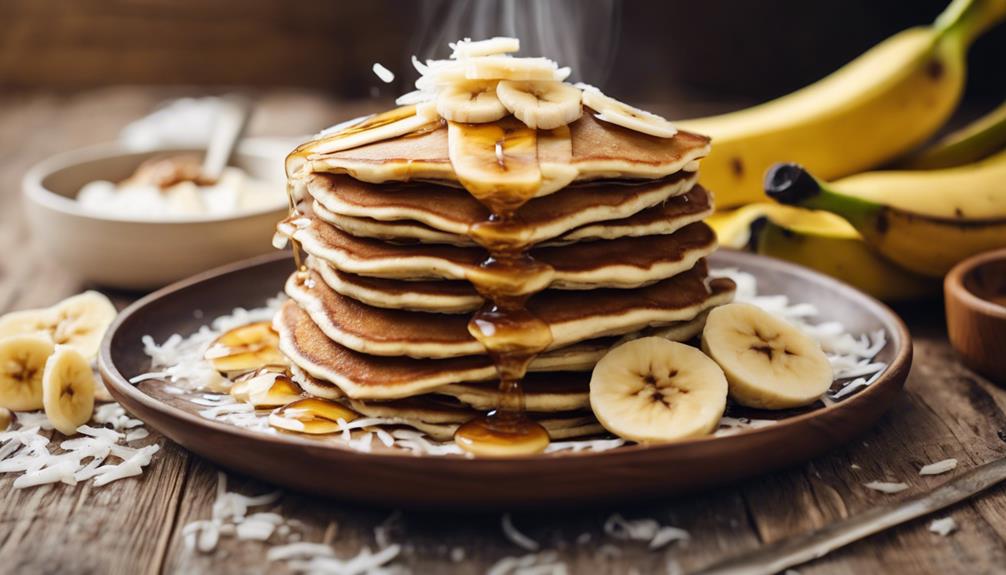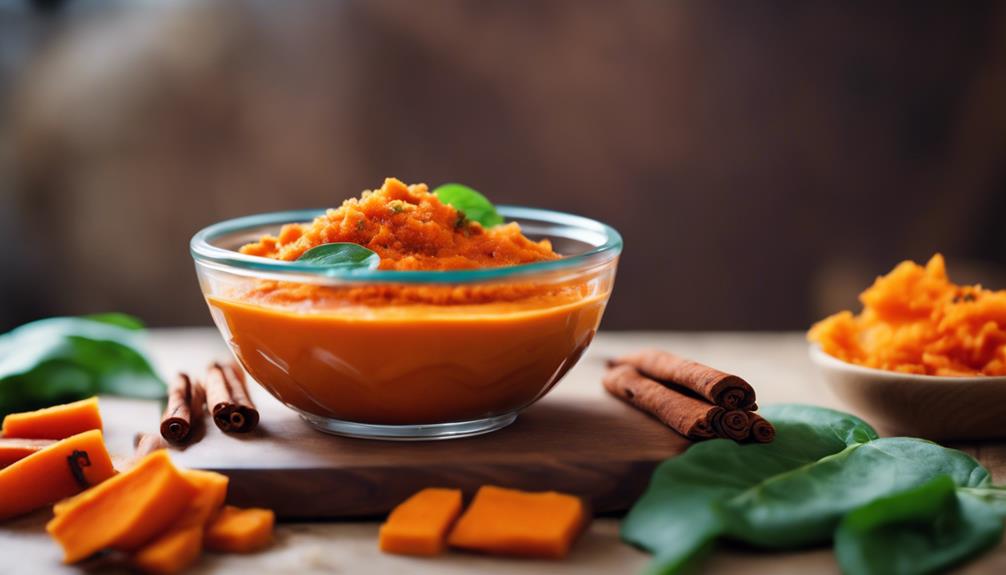Looking to kickstart your morning with a delicious and healthy boost? Try making some banana coconut pancakes! Filled with nutrients like potassium, protein, and essential vitamins, these gluten-free and dairy-free treats will make your taste buds sing. Simply blend coconut flour, ripe bananas, eggs, and a splash of vanilla extract for a tropical twist. Cook until perfectly golden, then garnish with shredded coconut, banana slices, and a drizzle of syrup for a heavenly breakfast delight. Interested in trying them out? Learn more about these delectable pancakes and uncover a treasure trove of flavor and wellness perks!
Key Takeaways
- Packed with potassium, protein, and vitamins from coconut flour and bananas.
- Gluten-free, dairy-free, and paleo-friendly for a nutritious breakfast.
- Satisfying healthy fats make them a delightful morning treat.
- Low in carbs, high in nutritional value, and bursting with flavor.
- Share with friends, top with coconut syrup, and spread #healthyforkful joy on social media.
Health Benefits of Banana Coconut Pancakes
By incorporating banana and coconut into your pancakes, you can enjoy a breakfast that not only tastes delicious but also provides numerous health benefits. The use of coconut flour makes these pancakes gluten-free and dairy-free, catering to various dietary needs. Additionally, shredded coconut adds a delightful texture and flavor to the pancakes. The mashed banana not only enhances the sweetness but also brings in essential nutrients like potassium for muscle function and blood pressure regulation.
Banana coconut pancakes offer a balanced meal by incorporating eggs that provide high-quality protein, vitamin A, B12, and folate acid. This combination of ingredients creates a powerhouse of nutrients in one tasty package.
The coconut in the pancakes is rich in healthy fats, which are beneficial for overall health. With the natural sweetness of bananas, these pancakes aren't only a treat for your taste buds but also a nutritious way to start your day.
Recipe for Banana Coconut Pancakes

How can you prepare these delectable Banana Coconut Pancakes at home?
To whip up a batch of these mouthwatering pancakes, you'll need coconut flour, ripe bananas, eggs, and a splash of vanilla extract. Start by mashing the ripe bananas until smooth, then mix in the eggs and dry ingredients like coconut flour.
Heat up a skillet on medium heat and pour the batter onto it to form your pancakes. Cook until golden brown on each side, then get ready to indulge in a stack of fluffy goodness.
These pancakes aren't just delicious; they're also gluten-free, dairy-free, and paleo-friendly, making them a perfect choice for a healthy breakfast.
To take these pancakes to the next level, consider adding some grilled banana slices on top for an extra burst of flavor. And the best part? You can store any leftover batter or cooked pancakes in the fridge for 2-3 days in an airtight container, so you can enjoy them whenever the craving strikes.
Time to get baking and treat yourself to a delightful morning meal!
Nutritional Value of Banana Coconut Pancakes

Discover the nutritional benefits of indulging in a serving of Banana Coconut Pancakes. These delightful pancakes not only offer a burst of flavor but also pack a punch when it comes to health benefits. The combination of coconut flour and bananas creates a nutritious breakfast option that's rich in potassium, protein, and essential vitamins, making it a great way to start your day on a healthy note.
The use of coconut flour provides a gluten-free alternative for those with dietary restrictions, while the natural sweetness and moisture from the bananas enhance the overall taste and texture of the pancakes. Additionally, the healthy fats present in these pancakes make them a satisfying choice that's low in carbs and high in nutritional value.
Furthermore, being dairy-free and paleo-friendly, these banana coconut pancakes cater to various dietary preferences without compromising on taste.
Sharing the Banana Coconut Pancake Recipe

Share the joy of Pancake Tuesday by spreading the delicious and nutritious banana coconut pancake recipe with your friends and family. These pancakes aren't only a delightful treat but also a healthier option for breakfast.
Here are a few tips to make the sharing experience even more enjoyable:
- Invite a Pancake Party: Gather your loved ones and make a fun event out of preparing and enjoying these tasty pancakes together.
- Snap and Share: Take mouth-watering photos of your coconut and banana pancakes and share them on social media using the hashtag #healthyforkful to inspire others to try the recipe.
- Create a Signature Syrup: Experiment with different toppings like coconut syrup to add a unique twist to your pancakes and make them even more irresistible.
With these simple and easy-to-make pancakes, you can savor your way to a scrumptious morning treat that everyone will love.
Next, let's delve into the cooking instructions to make sure your pancakes turn out perfect every time.
Cooking Instructions for Pancakes

To cook the banana coconut pancakes, start by scooping ¼ cup of batter onto a buttered skillet and cooking for 3-4 minutes until bubbles form. Then, flip the pancake and cook for an additional 2-3 minutes until golden brown. Repeat this process with the remaining batter to guarantee all pancakes are cooked evenly.
For extra flavor, finish off your pancakes with sliced bananas, shredded coconut, and a drizzle of syrup. Make sure to use a nonstick pan and cook on low-medium heat for the best results.
Before you start making the pancakes, remember to add melted butter, a teaspoon of baking powder, and a splash of vanilla extract to your batter for that extra delicious touch. If you can't find shredded coconut, don't worry – you can always substitute it with some chopped nuts or chocolate chips for a tasty twist!
Just keep an eye on those bubbles while cooking, and you'll have a stack of mouthwatering banana coconut pancakes ready to enjoy in no time.
Frequently Asked Questions
Can Bananas Be Too Ripe for Banana Pancakes?
Yes, bananas can be too ripe for banana pancakes. Overly ripe bananas may be mushy and affect the texture of the pancakes. Choose bananas with dark brown spots for the best sweetness and flavor, ensuring delicious results.
Is There a Healthy Way to Eat Pancakes?
You can absolutely devour healthier pancakes guilt-free! Whip up those banana coconut flapjacks loaded with nutrients. Indulge in a stack that's gluten-free, dairy-free, and paleo-friendly. It's a scrumptious and nourishing breakfast delight. Enjoy!
Are Banana Pancakes Good for Constipation?
Banana pancakes are good for constipation. Bananas provide dietary fiber, aiding digestion. Adding coconut flour boosts fiber content, promoting healthy bowel movements. Incorporating these into your diet can help regulate digestion and offer relief from constipation.
Why Are My Banana Pancakes Soggy?
To prevent soggy banana pancakes, make sure you drain excess liquid from ingredients like mashed bananas before adding them to the batter. Cooking on low heat for longer and allowing pancakes to cool on a wire rack helps maintain texture.
Conclusion
To sum up, banana coconut pancakes are a delightful and nourishing breakfast choice that will leave you feeling content and energized.
Did you know that bananas are a fantastic source of potassium, which aids in controlling blood pressure and enhancing heart health?
So, why not prepare a batch of these delicious pancakes and kickstart your day on the right note! Your taste buds and your body will appreciate it.
Enjoy!










